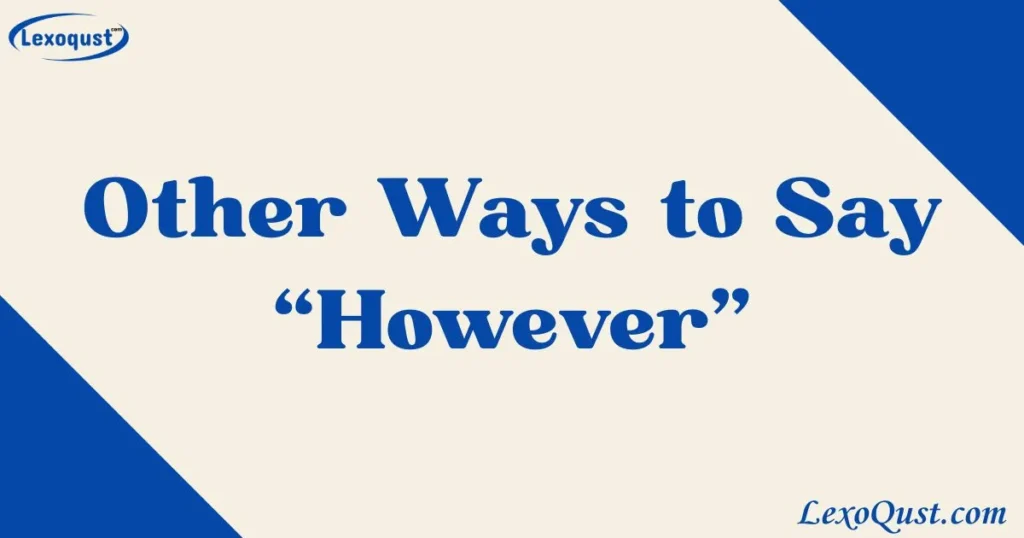Finding the right word can make all the difference in how your messages are received, especially when you’re aiming to express warmth, care, and understanding.
The word “however” often serves to signal contrast, but it can sometimes feel too formal or abrupt. That’s why discovering alternative phrases is key they can soften a point, add a personal touch, and bring more nuance to your writing.
In this guide, we’ll explore 30+ thoughtful ways to replace “however” with options that enhance clarity and communicate with greater empathy. Each comes with meanings, examples, and explanations to help you connect more naturally with your readers.
What Does “However” Mean?
“However” is a transitional word used to introduce a contrast, exception, or contradiction to a previous statement. It signals a shift in direction, much like saying “on the other hand” or “yet.” For example, in the sentence “The proposal was strong; however, it lacked clear financial backing,” the word however highlights the contrast between the proposal’s strengths and its limitations. It’s commonly used in essays, emails, and reports to add structure and logic to writing.
When to Use “However”
Use however when you want to:
- Present a contrasting idea or opposing viewpoint.
- Acknowledge a point but introduce an exception.
- Transition smoothly between thoughts in formal writing.
It’s especially helpful in academic, technical, or business communication where clarity and structured argument are essential. For instance:
“We intended to launch this week. However, the testing phase uncovered unexpected bugs.”
Is It Professional/Polite to Say “However”?
Yes, “however” is considered both professional and polite in most formal contexts. It’s widely accepted in business emails, research papers, and official documents. However, in more personal or conversational writing, it can come off as stiff or overly formal. In those cases, you might choose alternative phrases like:
- That said
- Even so
- Still
- On the flip side
- Nevertheless
These options maintain the same meaning but add more warmth, nuance, and a personal touch—especially when you’re aiming to communicate with empathy and avoid abruptness.
By understanding when and how to use however, and knowing when to replace it with a more natural or thoughtful alternative, you’ll improve the clarity, flow, and tone of your writing across a variety of settings.
1. Nevertheless
Meaning: Introduces a contrast while reinforcing the initial idea.
Definition: A transition word used to indicate that something happens despite a previous point.
Tone: Formal and resilient.
Example: The deadline was tight; nevertheless, we completed the project on time.
Explanation: This phrase shows persistence in the face of a challenge, which helps readers appreciate determination.
Purpose and Personalization: Use it to show continuity despite opposition. It suits formal writing but can be made warmer by pairing with personal insight.
2. Nonetheless
Meaning: Adds a contrasting idea without negating the previous one.
Definition: A synonym of “nevertheless” used to introduce a concession or exception.
Tone: Balanced and thoughtful.
Example: The review was critical; nonetheless, it offered valuable feedback.
Explanation: It helps maintain neutrality and shows both sides of a situation.
Purpose and Personalization: Ideal for essays and reports; personalize it by pairing with empathetic phrases to soften criticism.
3. On the Other Hand
Meaning: Presents an opposing viewpoint or alternative.
Definition: A phrase used to compare two differing ideas or arguments.
Tone: Objective and comparative.
Example: He enjoys routine. On the other hand, his partner thrives on spontaneity.
Explanation: It highlights contrasts clearly, aiding the reader in weighing perspectives.
Purpose and Personalization: Great for persuasive writing. Adjust formality by using it conversationally or with more precise qualifiers.
4. Still
Meaning: Indicates continuation or persistence despite previous information.
Definition: A brief connector that introduces a contrasting thought.
Tone: Neutral and slightly informal.
Example: The offer wasn’t perfect. Still, it was better than nothing.
Explanation: Keeps the tone relatable while acknowledging opposing points.
Purpose and Personalization: Works well in both casual and business writing; keep it concise for a snappier tone.
5. Yet
Meaning: Expresses an unexpected continuation.
Definition: A conjunction that connects ideas showing contrast or surprise.
Tone: Curious or reflective.
Example: He failed several times, yet he never gave up.
Explanation: Enhances storytelling by showing resilience or contradiction.
Purpose and Personalization: Use it to emphasize contrast; pair with emotionally resonant context for greater impact.
6. Even So
Meaning: Acknowledges a fact but offers a counterpoint.
Definition: A phrase meaning “despite that” or “nonetheless.”
Tone: Gentle and nuanced.
Example: She was tired. Even so, she stayed late to help.
Explanation: Adds depth by highlighting effort or sacrifice.
Purpose and Personalization: Use in empathetic writing. Customize with emotive detail for greater connection.
7. Though
Meaning: Introduces a contrast or exception.
Definition: A conjunction that indicates opposition or contrast.
Tone: Conversational and flexible.
Example: It was risky, though ultimately successful.
Explanation: It’s brief but powerful in changing direction.
Purpose and Personalization: Best in informal writing; position it for rhythm and tone variation.
8. In Contrast
Meaning: Highlights clear differences between ideas.
Definition: A phrase that introduces a differing perspective.
Tone: Analytical and clear-cut.
Example: The city was bustling. In contrast, the countryside felt serene.
Explanation: It helps create structure in comparative writing.
Purpose and Personalization: Use in essays or reports; personalize by following with sensory or emotional detail.
9. Conversely
Meaning: Flips the perspective to show an opposite effect.
Definition: A formal way to express reversal or contrast.
Tone: Scholarly and precise.
Example: She prefers solitude. Conversely, he thrives in crowds.
Explanation: Strengthens the logical flow of ideas.
Purpose and Personalization: Ideal in academic or business writing; adjust tone with examples that reflect your audience.
10. Then Again
Meaning: Introduces reconsideration or second thoughts.
Definition: A phrase used to show a change in opinion or outlook.
Tone: Reflective and informal.
Example: I thought I was ready. Then again, maybe not.
Explanation: Adds authenticity and human thought processes.
Purpose and Personalization: Great for blog posts and narrative writing; personalize by expressing internal dialogue.
11. In Any Case
Meaning: Returns focus to the main point despite contrast.
Definition: A transition that emphasizes a consistent outcome.
Tone: Reassuring and conclusive.
Example: We had doubts. In any case, we moved forward.
Explanation: Re-centers the reader, helping wrap up tangents.
Purpose and Personalization: Useful in emails or persuasive writing; soften with context-specific reassurance.
12. That Said
Meaning: Concedes a point while introducing a qualifier.
Definition: A phrase used to introduce an exception or refinement.
Tone: Balanced and considerate.
Example: Your argument is valid. That said, there are other factors to consider.
Explanation: Shows openness while maintaining your stance.
Purpose and Personalization: Great for respectful disagreements. Tailor with personal acknowledgment for warmth.
13. At the Same Time
Meaning: Shows simultaneous or coexisting ideas.
Definition: Indicates two things happening concurrently.
Tone: Thoughtful and neutral.
Example: He’s independent. At the same time, he values teamwork.
Explanation: Encourages seeing complex truths.
Purpose and Personalization: Use in nuanced arguments; personalize by adding emotional or relational depth.
14. All the Same
Meaning: Emphasizes consistency despite contrast.
Definition: Another way to say “regardless” or “still.”
Tone: Warm and understanding.
Example: She was upset. All the same, she smiled politely.
Explanation: Helps convey maturity or grace.
Purpose and Personalization: Ideal in reflective writing. Use in emotionally intelligent contexts.
15. Be That as It May
Meaning: Acknowledges a point while preparing to move on.
Definition: A formal concession phrase.
Tone: Respectful but assertive.
Example: The team lacked experience. Be that as it may, they delivered results.
Explanation: Balances courtesy with confidence.
Purpose and Personalization: Great in professional contexts. Personalize with positive affirmation.
16. Even Though
Meaning: Expresses contradiction between cause and effect.
Definition: A subordinating conjunction showing unexpected results.
Tone: Empathetic or surprising.
Example: Even though she feared public speaking, she gave a compelling speech.
Explanation: Builds emotional stakes.
Purpose and Personalization: Use in storytelling or persuasive writing; personalize by highlighting personal struggle.
Learn More> Other Ways to Say “How Cool”
17. With This in Mind
Meaning: Prepares the reader for a point based on prior info.
Definition: A phrase used to shift into a related perspective.
Tone: Logical and guiding.
Example: With this in mind, we decided to delay the launch.
Explanation: Keeps reasoning transparent.
Purpose and Personalization: Use in process explanations; personalize by including motivation or intention.
18. Despite This
Meaning: Highlights persistence or contradiction.
Definition: A phrase used to show continuation in opposition.
Tone: Determined and firm.
Example: The odds were against us. Despite this, we succeeded.
Explanation: Inspires resilience in the reader.
Purpose and Personalization: Works well in motivational writing. Add personal anecdotes for inspiration.
19. All Things Considered
Meaning: Summarizes a balanced judgment.
Definition: A phrase to introduce an overall evaluation.
Tone: Concluding and reflective.
Example: All things considered, the trip was a success.
Explanation: Helps wrap up thoughts thoughtfully.
Purpose and Personalization: Use in final paragraphs; personalize by including what matters most to your audience.
20. On the Contrary
Meaning: Refutes a previous statement or assumption.
Definition: A formal way to oppose a prior point.
Tone: Bold and assertive.
Example: You think I’m upset? On the contrary, I’m thrilled.
Explanation: Makes strong rebuttals clear.
Purpose and Personalization: Use for clarity; adjust tone to sound less confrontational if needed.
21. Rather
Meaning: Offers correction or clarification.
Definition: A transitional adverb to present an alternative.
Tone: Corrective and precise.
Example: It wasn’t boring—rather, it was deeply introspective.
Explanation: Enhances precision and sharpens clarity.
Purpose and Personalization: Great for refining meaning. Match your voice to the reader’s expectations.
22. In Light of That
Meaning: Shows conclusion or adjustment based on prior info.
Definition: A phrase that explains change or reaction.
Tone: Practical and adaptive.
Example: In light of that feedback, we revised our approach.
Explanation: Reflects open-mindedness and adaptability.
Purpose and Personalization: Use in action-based writing. Personalize by connecting to real-world decisions.
23. Whereas
Meaning: Compares two contrasting statements.
Definition: A conjunction used to show difference.
Tone: Analytical and formal.
Example: He enjoys risk, whereas she prefers security.
Explanation: Provides side-by-side clarity.
Purpose and Personalization: Ideal for structured comparisons. Keep tone formal or soften with narrative flow.
24. Regardless
Meaning: Ignores the significance of prior detail.
Definition: A transition that indicates something happens anyway.
Tone: Assertive and direct.
Example: Regardless of cost, we chose quality.
Explanation: Signals firm commitment.
Purpose and Personalization: Use when emphasizing non-negotiables. Make it warmer with context or empathy.
25. Albeit
Meaning: Softens a contrasting clause.
Definition: A formal conjunction meaning “although.”
Tone: Subtle and literary.
Example: The room was beautiful, albeit a bit small.
Explanation: Adds refinement and nuance.
Purpose and Personalization: Best for essays and articles. Use sparingly for elegance.
26. But
Meaning: Introduces contradiction or limitation.
Definition: A coordinating conjunction for contrast.
Tone: Neutral and versatile.
Example: She wanted to leave, but she stayed.
Explanation: Keeps writing direct and clear.
Purpose and Personalization: Universally useful; adjust tone by sentence length and rhythm.
27. Instead
Meaning: Offers a replacement idea.
Definition: An adverb meaning “as an alternative.”
Tone: Practical and decisive.
Example: We didn’t drive. Instead, we took the train.
Explanation: Helps shift focus easily.
Purpose and Personalization: Use for variety; personalize by linking to goals or values.
28. Otherwise
Meaning: Warns of consequences or presents alternatives.
Definition: A conditional adverb.
Tone: Cautious and informative.
Example: Finish the form; otherwise, your application won’t be processed.
Explanation: Clarifies outcomes.
Purpose and Personalization: Perfect for instructions. Soften tone by adding positive reinforcement.
Learn More> Other Ways to Say “Not Only”
29. Still and All
Meaning: Expresses continuation despite obstacles.
Definition: An informal phrase meaning “nonetheless.”
Tone: Folksy and warm.
Example: It was a mess. Still and all, we laughed.
Explanation: Adds charm and humanity.
Purpose and Personalization: Great for storytelling; personalize with voice and tone.
30. With That
Meaning: Concludes or transitions to the next step.
Definition: A phrase to close a thought or shift focus.
Tone: Final and reflective.
Example: With that, we wrapped up the meeting.
Explanation: Signals closure with ease.
Purpose and Personalization: Ideal for transitions; adjust by using in narration or summaries.
31. Though That May Be True
Meaning: Concedes a point but suggests further discussion.
Definition: A phrase acknowledging truth before adding contrast.
Tone: Diplomatic and gentle.
Example: Though that may be true, more data is needed.
Explanation: Keeps tone respectful while pushing forward.
Purpose and Personalization: Good for soft rebuttals. Use in persuasive and academic writing.
32. Even Then
Meaning: Describes continuity despite previous conditions.
Definition: Suggests persistence or unchanging outcomes.
Tone: Steady and reflective.
Example: We planned well. Even then, challenges arose.
Explanation: Adds realism to planning narratives.
Purpose and Personalization: Ideal in recounting lessons. Personalize with insight.
33. Just the Same
Meaning: Indicates similar results despite difference.
Definition: A phrase meaning “anyway” or “nonetheless.”
Tone: Warm and familiar.
Example: He didn’t apologize. Just the same, I forgave him.
Explanation: Shows maturity and compassion.
Purpose and Personalization: Use in reflective or emotional writing. Adjust tone with surrounding context.
34. Having Said That
Meaning: Balances a point with a qualifier.
Definition: A phrase used to pivot while maintaining continuity.
Tone: Conversational and flexible.
Example: The event was long. Having said that, it was memorable.
Explanation: Keeps thoughts balanced and organized.
Purpose and Personalization: Useful in articles and speeches. Match your style for rhythm.
35. At Any Rate
Meaning: Reinforces a decision or point despite earlier content.
Definition: A transition to reaffirm or summarize.
Tone: Reassuring and firm.
Example: We faced setbacks. At any rate, the launch happened.
Explanation: Anchors your writing with clarity.
Purpose and Personalization: Perfect for closing thoughts. Soften or sharpen depending on audience.
Conclusion
Choosing the right words especially alternatives to “however” can make your messages feel more thoughtful, authentic, and nuanced. Whether you’re crafting an academic essay, a heartfelt letter, or a blog post, small shifts in language can bring greater warmth, clarity, and understanding.
I hope this guide has helped you explore alternative phrases that add both empathy and precision to your writing. Every writer’s voice is unique so don’t be afraid to personalize these options to fit your tone. Keep writing with intention, and let your words build stronger, more meaningful connections. Thanks for stopping by I’m glad this helped you grow.

Hi! I’m Amelia Ashford, the admin of Lexoqust.com. Here, we dive deep into the world of synonyms to help you express yourself better.From everyday words to advanced vocabulary, Lexoqust makes your writing richer and more refined.



